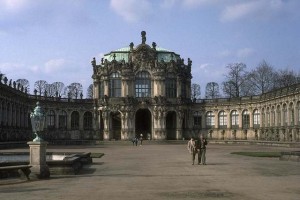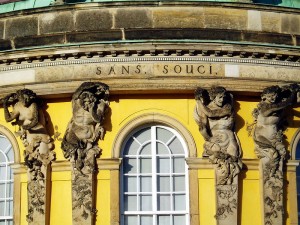The Sanssouci Palace is known for its blend of French and Italian Rococo styles. These styles, a slightly less lavish subset of Baroque, display beauty and elegance as well as an heir of comfort, fitting for the summer palace.
The choice of the more subtle Rococo over Baroque gives an insight into the monarch’s plans for the summer home. Frederick “preferred a secluded residence to a vast palace” (Held and Posner 387). Instead of following his earlier French counterparts, who designed multi-level, extravagant palaces, Frederick’s one-story home was meant for relaxation and getting away.
Frederick’s architect, Georg Wenzeslaus von Knobelsdorff, was versed in many different architectural styles including French and Italian Rococo styles after having traveled across Europe. The main entrance of the palace shows the dichotomy of the architect’s preferred styles: “The entrance court with its Corinthian colonnades shows Knobelsdorff’s tendency to a purer classicism. The garden front with its domed projecting centre is very evidently of Parisian derivation” (Summerson 31).
The first view of the palace, with the six tiered staircase and orangery shows another architectural influence—this one German. The “paired herms between high bay windows, was probably derived from Poppelmann’s Zwinger pavilions,” a palace in Dresden, Germany. The difference, however, is that for the Sanssouci Palace, the atlantes (architectural statues of men–derivation: Atlas) are functional, while the Zwinger pavilion decorations are purely for aesthetics (Held and Posner 388). This ideal is important to understanding Frederick, a seemingly shy and humble man, and his desire to get away from the spotlight.
Other scholars interpret the mix between French and Italian Rococo styles differently: “The stylistic varieties of Potsdam expose very clearly the restlessness of the ‘forties – a restlessness beginning to be felt in all countries and which was only to be resolved in the renewed interest in theoretical principle in the next decade” (Summerson 32).
[**Photo 3: “Zwinger Pavilion” by Penn State University Library is licensed under Creative Commons 2.0 Generic. **Photo 4: “Bronze letters “SANS SOUCI” at Sanssouci, Potsdam, Germany” by Suse is licensed under the Creative Commons Attribution-Share Alike 3.0 Unported license.]



